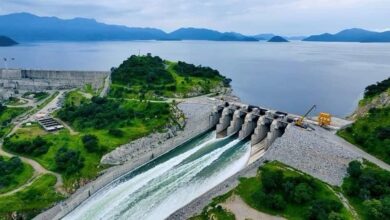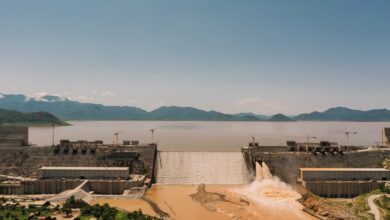
Egyptian Foreign Minister Mohamed Kamel Amr has held intensive talks in Ethiopia's capital Adis Ababa over the ongoing Grand Renaissance Dam crisis, days after the Ethiopian parliament approved the Entebbe Agreement on the redistribution of River Nile water. The development had only added fuel to the fire in a crisis that has seen Cairo recently waive military action while an Ethiopian government spokesperson has said the project is non-negotiable.
In a report, entitled "Egypt's Limited Military Options to Stop an Ethiopian Dam Project," Stratfor Global Intelligence assesses the difficulties Egypt's air forces could encounter in the event of a direct military strike on the dam. It argues that the Egyptin army lacks the sufficient aerial refuelling capabilities that would allow its fighters to fly the long distances to Ethiopia. This suggests Egypt would have to rely on Sudan as a staging point for a blitzkrieg strike. The Grand Renaissance Dam is only 12 kilometres from Sudan's borders.
However, the report explains, an indirect military solution is contingent on Sudan's approval because it would expose Ethiopia's next-door neighbour to potentially dire consequences that could amount to all-out war. This makes a Sudanese agreement for Egypt to launch military sorties from its territory much less likely.
Ruling out military action leaves Egypt with less violent and less expensive options. These could include backing Ethiopian opposition groups or investing in religious or ideological conflicts between radical Islamist groups – most active in Somalia and Eritrea – and Adis Ababa's Orthodox Christian regime. These groups could be co-opted to pressure the Ethiopian government by launching targeted operations into the heart of the country.
Egypt might also consider supporting separatist ethnicities such as the Oromia tribes who for a long time now have attacked perceived marginalisation and been represented by armed groups seeking to claim their rights by force.
As well as the Oromia, Ethiopia's Ogaden region is home to a Somali-origin majority where several radical groups are looking to break free from Ethiopia and join Somalia instead.
The diplomatic route, although it would not bring about an immediate solution, will remain an important "soft" option for Egypt's leadership. Its slow impact and dependance on timing might make it the best possible scenario. Egypt might, for example, resort to the United Nations Security Council or the International Court of Justice. It could also opt for political means such as mediation by parties with influence over Ethiopia – namely the African Union, the New Partnership for Africa's Development (NEPAD) and Common Market for Eastern and Southern Africa (COMESA). Egypt could also approach countries funding the Ethiopian dam, including China and Italy.
International precedent for this route should be cause for encouragement. The International Court of Justice, in its most recent adjudications on water disputes between Hungary and Slovakia in 1997; and Uruguay and Argentina in 2010, concluded that regional treaties, including those on international rivers, should be irrevocable because they are inherited by consecutive governments.
This "soft" approach is the most subtle but the most difficult at the same time, due to considerations of time and lack of trust between parties involved in the conflict. Despite those challenges, this option remains necessary for handling any future disputes over water issues between the two countries.
In this context, Egypt could engage in the Ethiopian project at the levels of funding, implementation and consultancy, turning it into a principal partner. That would allow Egypt to ensure that the project is executed according to technical specifications that take into account environmental considerations, sustainable development and continued water flow, thereby serving the interests of all parties.
The piece is a summary of an analysis by Al-Masry Studies and Information Centre


